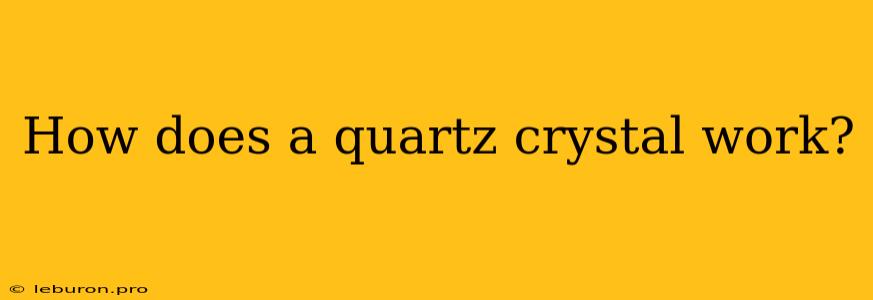Quartz crystals are ubiquitous in modern technology, playing crucial roles in timekeeping, electronics, and even telecommunications. These seemingly simple crystals possess an extraordinary ability to convert mechanical energy into electrical energy and vice versa, making them essential components in a wide range of devices. But how does a quartz crystal work, and what makes it so special? This article delves into the fascinating world of quartz crystals, exploring their structure, properties, and the mechanisms behind their remarkable functionality.
The Structure and Properties of Quartz Crystals
Quartz crystals, chemically known as silicon dioxide (SiO2), are naturally occurring minerals with a unique crystalline structure. This structure is responsible for the piezoelectric effect, a phenomenon that lies at the heart of quartz crystal functionality. The arrangement of silicon and oxygen atoms within the crystal lattice forms a rigid, stable structure with a slight asymmetry. This asymmetry is key to the piezoelectric effect, as it creates a separation of electrical charges when the crystal is subjected to mechanical stress.
The Piezoelectric Effect
The piezoelectric effect refers to the ability of certain materials, including quartz, to generate an electrical charge in response to applied mechanical stress. When a quartz crystal is squeezed or stretched, the atoms within the crystal lattice shift slightly, creating a separation of positive and negative charges at the crystal's surface. This separation of charges constitutes an electric potential difference, generating a measurable voltage. Conversely, applying an electric field to the crystal will cause it to deform, illustrating the reverse piezoelectric effect.
The Resonant Frequency of Quartz Crystals
One of the most important properties of quartz crystals is their resonant frequency. Every quartz crystal has a specific natural frequency at which it vibrates when subjected to an electrical or mechanical stimulus. This resonant frequency is determined by the crystal's size, shape, and the way it is cut. When a quartz crystal is subjected to an alternating electric field at its resonant frequency, it will vibrate with a high amplitude, amplifying the electrical signal.
Applications of Quartz Crystals
The piezoelectric and resonant properties of quartz crystals make them incredibly versatile and valuable components in a variety of applications. Here are some of the most common uses of quartz crystals:
Timekeeping and Clocks
Quartz crystals are the heart of modern timekeeping devices, from wristwatches to atomic clocks. The precise and stable resonant frequency of a quartz crystal is used to create an accurate timekeeping mechanism. In a quartz watch, an electronic oscillator circuit excites the quartz crystal at its resonant frequency, causing it to vibrate consistently. These vibrations are then counted by a digital counter, providing a precise measurement of time.
Electronics and Oscillators
Quartz crystals play a vital role in electronic circuits as oscillators, providing a stable and accurate reference frequency for various electronic devices. They are used in computers, mobile phones, and other electronic devices to regulate timing signals and ensure the smooth operation of electronic systems. The precise frequency generated by a quartz crystal allows for the synchronized operation of electronic components, enabling the accurate execution of complex operations.
Telecommunications
Quartz crystals are also crucial components in telecommunications equipment, contributing to the stable transmission and reception of radio waves. They are used in filters and oscillators within radio transceivers and other communication devices, helping to isolate specific frequencies and ensure the clarity and reliability of communication signals.
Sensors and Measurement Devices
Quartz crystals can be used in a variety of sensors to measure physical quantities like pressure, acceleration, and temperature. These sensors utilize the piezoelectric effect to generate an electrical signal proportional to the measured quantity. For instance, a quartz pressure sensor will produce a voltage output proportional to the applied pressure, allowing for precise pressure measurements.
Conclusion
Quartz crystals are truly remarkable materials that have revolutionized various fields, from timekeeping and electronics to telecommunications and sensing. Their piezoelectric effect, coupled with their stable and predictable resonant frequency, makes them indispensable in modern technology. As our understanding of these materials continues to evolve, we can expect even more innovative applications of quartz crystals in the future.
